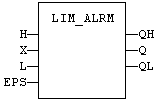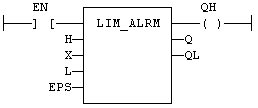![]()
 Function Block - Detects high and low limits of a signal with hysteresis.
Function Block - Detects high and low limits of a signal with hysteresis.
Inputs
|
Input |
Data Type |
Range |
Unit |
Default |
Description |
|---|---|---|---|---|---|
|
EPS |
REAL |
|
|
|
Value of the hysteresis. |
|
H |
REAL |
|
|
|
Value of the high limit. |
|
L |
REAL |
|
|
|
Value of the low limit. |
|
X |
REAL |
|
|
|
Input signal. |
Outputs
|
Output |
Data Type |
Range |
Unit |
Description |
|---|---|---|---|---|
|
Q |
BOOL |
|
|
TRUE if the signal exceeds one of the limits. Equals to QH OR QL. |
|
QH |
BOOL |
|
|
TRUE if the signal exceeds the high limit. |
|
QL |
BOOL |
|
|
TRUE if the signal exceeds the low limit. |
Remarks
None
FBD Language Example

FFLD Language Example
- In the FFLD Language, the input rung (EN) is used for enabling the block.
- The output rung is the QH output.
- The block is not called if EN is FALSE.

IL Language Example
(* MyAlarm is a declared instance of LIM_ALRM function block *)
Op1: CAL MyAlarm (H, X, L, EPS)
FFLD MyAlarm.QH
ST QH
FFLD MyAlarm.Q
ST Q
FFLD MyAlarm.QL
ST QL
ST Language Example
(* MyAlarm is a declared instance of LIM_ALRM function block *)
MyAlarm (H, X, L, EPS);
QH := MyAlarm.QH;
Q := MyAlarm.Q;
QL := MyAlarm.QL;
See Also






